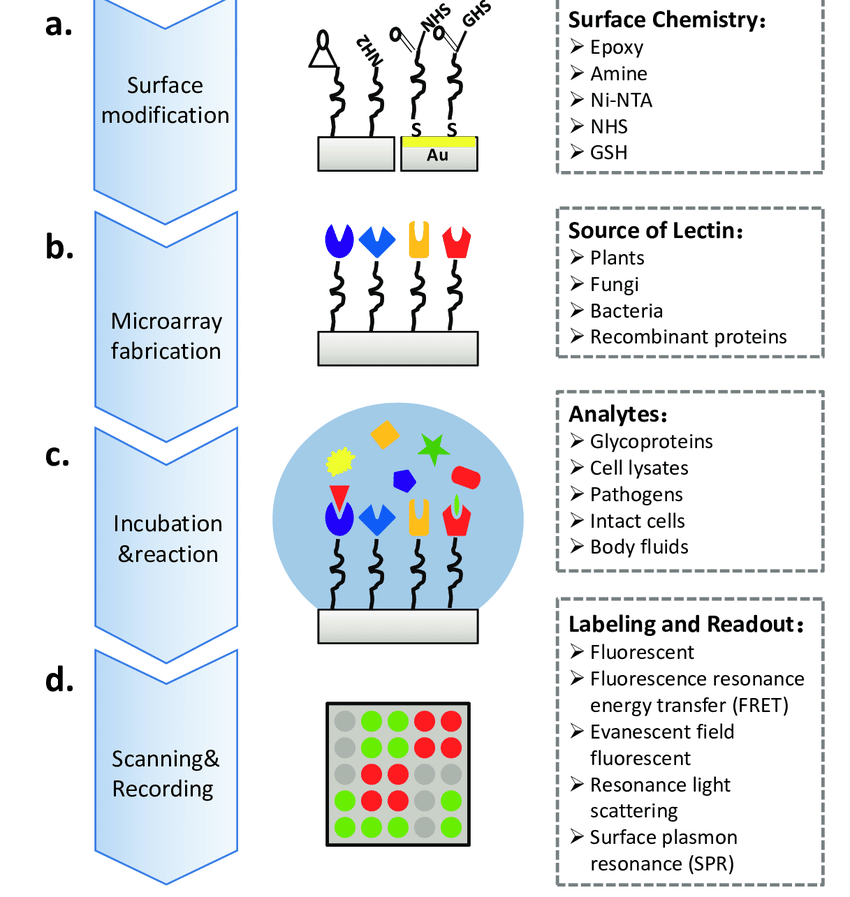Lectin Microarray Service
- Glycan Structure Analysis
- Glycoprotein Binding Characterization
- Glycan Biomarker Identification and Disease Research
- Drug Development
- Glycan Biosensor Development
Lectin Microarray Service refers to a high-throughput analysis service that fixes a group of lectins with clear sugar chain recognition specificity onto a solid support to construct a spatially encoded microarray for detecting the presence, abundance and distribution characteristics of sugar chain structures in biological samples. This technology involves binding fluorescently or biotin-labeled carbohydrate samples to the lectins on the array. The binding events are visualized and quantified through methods such as fluorescence scanning, allowing rapid acquisition of glycan expression profile information in the target sample.
Glycans are one of the most abundant biomolecules on the cell surface, and their expression and modification patterns often change significantly in response to cell state, developmental stage, or disease progression. As a result, glycans serve as important disease biomarkers and potential therapeutic targets. Lectins, as natural glycan-recognizing proteins, are essential tools in studying glycan distribution and function due to their broad and structurally selective binding ability. In the context of traditional glycan research methods being limited in throughput and complex in structural analysis, the Lectin Microarray has emerged as a solution. By integrating multiple lectins through microarray technology, it can systematically reveal the diversity and expression patterns of glycan structures in biological samples within a single experiment. It is widely applied in glycobiology research, disease biomarker discovery, cell phenotype analysis, and drug development.
MtoZ Biolabs offers the Lectin Microarray Service utilizing a variety of structurally defined and highly specific lectins to perform parallel detection of glycans in biological samples, allowing for the creation of glycan expression profiles, the analysis of glycosylation patterns, and the identification of changes across different biological states. The service is suitable for analyzing the glycan composition and modification features in serum, tissue extracts, cell lysates, glycoproteins, or polysaccharide samples.
Analysis Workflow
The general workflow for the Lectin Microarray Service is as follows:
1. Project Evaluation and Design
Define research objectives and select appropriate lectins based on the requirements, then design the experimental plan.
2. Lectin Array Preparation
Immobilize various lectins onto a solid support to create a microarray layout, followed by quality control.
3. Sample Preparation and Labeling
Label the glycan samples with fluorescent or biotin markers, ensuring uniform labeling with sufficient sensitivity.
4. Sample Incubation and Washing
Incubate labeled samples with the lectin array and perform rigorous washing to remove non-specific binders.
5. Signal Detection and Data Collection
Use a high-resolution fluorescence scanner to capture binding signals, generating raw images and data.
6. Data Analysis and Report Generation
Standardize the data and perform bioinformatics analysis to generate binding spectra, heatmaps, and a detailed analysis report.

Zhou SM. et al. Comb Chem High Throughput Screen. 2011.
Figure 1. The procedure for a typical lectin microarray experiment.
Service Advantages
High-Throughput Screening Capability: A single experiment can simultaneously analyze hundreds of glycan-lectin interactions, significantly improving research efficiency.
High Sensitivity and Specificity: Using a fluorescence detection system, the service can accurately capture weak glycan-lectin binding signals, ensuring data accuracy with minimal background noise.
Customized Services: Lectins and sample types can be flexibly selected based on research needs, meeting diverse scientific requirements.
Multi-Dimensional Data Acquisition: Simultaneous collection of binding data for various glycan structures aids in comprehensive analysis of the glycosylation landscape.
Compatibility with Multi-Platform Integrated Analysis: The service can be combined with techniques like mass spectrometry for joint analysis, expanding the depth of glycan structure and function analysis.
Sample Submission Suggestions
We support various sample types, including glycoproteins, cell lysates, serum/plasma, tissue extracts, and more. Please ensure samples are shipped under cold storage conditions. For special sample or labeling requirements, feel free to contact the MtoZ Biolabs' technical team in advance to obtain personalized sample preparation guidelines.
Applications
Applications of the Lectin Microarray Service include but are not limited to:
Systematically analyze the types, structures, and diversity of glycans, providing foundational data for glycobiology research.
Study the binding specificity between glycoproteins and lectins, exploring the role of glycosylation in cellular functions.
Identify potential glycosylation biomarkers by comparing glycan differences between healthy and diseased samples, aiding in disease diagnosis and targeted therapies.
In drug development, study glycan-lectin interactions to screen small molecules and glycomolecules with biological activity, supporting drug screening and optimization.
Develop detection platforms specifically designed to recognize glycan structures for molecular recognition, biological diagnostics, and environmental monitoring.
Deliverables
1. Comprehensive Experimental Details
2. Materials, Instruments, and Methods
3. Total Ion Chromatogram & Quality Control Assessment (project-dependent)
4. Data Analysis, Preprocessing, and Estimation (project-dependent)
5. Bioinformatics Analysis
6. Raw Data Files
Related Services
Heparin Sulfate Microarray Service
How to order?







